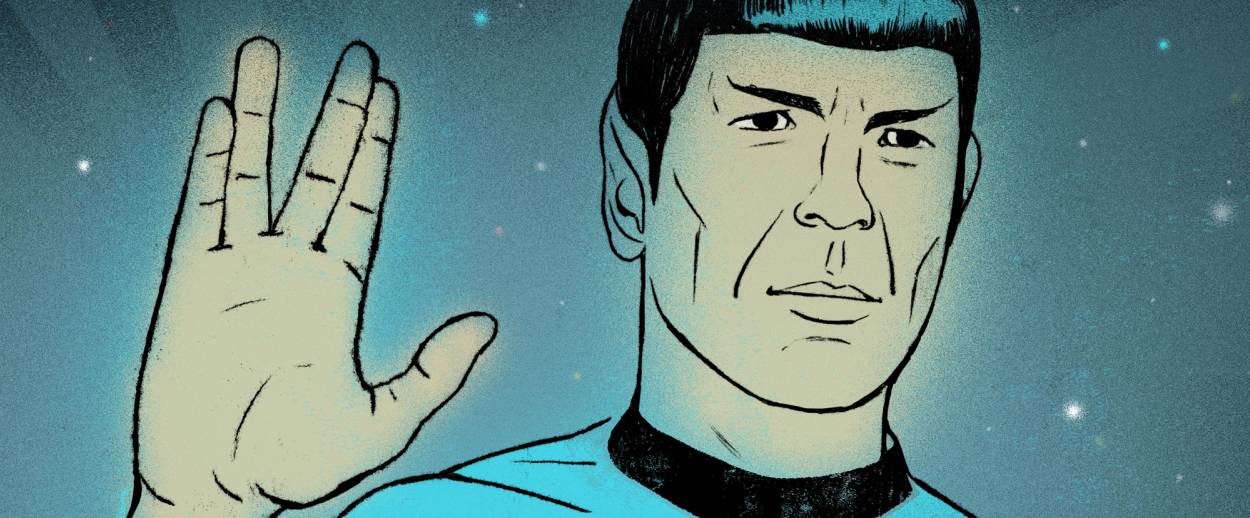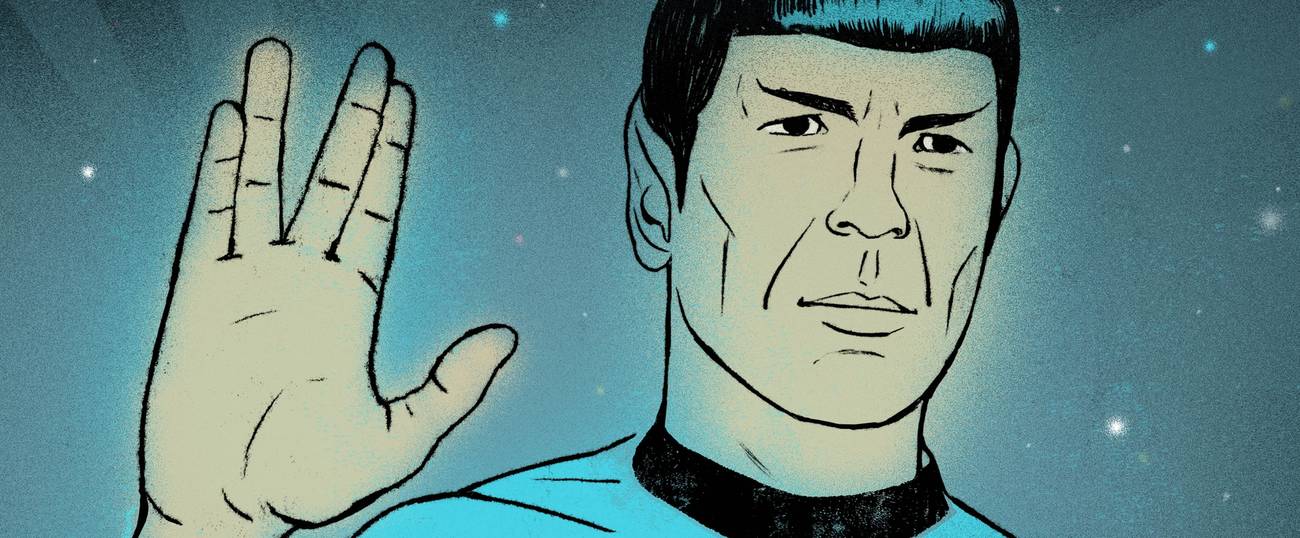Leonard Nimoy’s ‘Fascinating’ Life
A new children’s book delves into the ‘Star Trek’ star’s Jewish biography




We are having a Spock moment. Not just because this year is the 50th anniversary of Star Trek; not just because Leonard Nimoy’s son Adam’s new documentary, For the Love of Spock, is playing in theaters around the country; not just because this summer saw the appearance of a JJ Abrams Trek movie; not just because the Intrepid Sea, Air & Space Museum on Pier 86 in New York City has launched “The Starfleet Academy Experience,” a 12,000-foot immersive exhibition that sounds, frankly, exhausting.
No, for me, the Spock moment is because there’s a wonderful new biography of Nimoy for children, and it’s one of the most unapologetically Jewish profiles for kids in ages. It made me cry.
Fascinating: The Life of Leonard Nimoy begins by introducing us to “Lenny” as a third-grader, singing “God Bless America” at a 1939 talent show at a Boston settlement house. He’d been discovered after the settlement house’s social director heard him singing the Shema in shul. The book quickly immerses us in the smells and sounds of Lenny’s immigrant West End neighborhood. The text is peppered with the word “fascinating” as ever-curious, ever-artistic Leonard observes the world around him, including watching men wrapped in tallitot on Rosh Hashanah making the familiar gesture of the priestly blessing that became “live long and prosper.” We meet his fearful parents, who’d escaped pogroms and didn’t want their son to be a risk-taker. We meet his bubbe and zayde, who encouraged Lenny to explore the world. We learn about his love of his Kodak camera, which helped him look closely at his father’s face and see the way his father worked to appear emotionless. Cast in Clifford Odets’s Awake and Sing—a play about three generations of a poor Jewish family in a tenement apartment—Lenny gets a scholarship to Boston College’s summer theater program, and he soon decides to be an actor. “In September 1949,” the text says, “he was standing at South Station, wearing a blue double-breasted suit from Filene’s Basement and holding a train ticket to California.” (His father’s parting words: “Learn to play the accordion. … Actors starve, but at least musicians can eke out a living.”) While driving a taxi to support himself, Lenny hears a familiar Boston accent and winds up getting a pep talk from then-Congressman John F. Kennedy. We learn about Nimoy’s concerns about taking the role of Spock—“he would have to wear pointy ears and a silly haircut”—and how he considered the decision logically. “[H]e remembered looking at his own father through the camera lens and seeing all the hidden emotion in his face.” This informs his portrayal of the Vulcan, as does his own view of himself as an alien.
The book’s beautiful, hip-but-not-achingly-hipster illustrations, in a palette of sepia tones and rich blues, are by Edel Rodriguez. One lovely spread shows young Lenny developing photos of his family in the tenement’s darkened bathroom, which Rodriguez sprinkles with dots of light, like a night sky. Like most children’s book writers, author Richard Michelson didn’t choose his book’s illustrator, but he was delighted with the choice. Rodriguez is a graphic designer (he did that recent, memorable Trump meltdown cover for Time Magazine ) whose cool sensibility should appeal to sci-fi types as well as fans of sentimental immigrant tales. “I didn’t know this when I found out we’d be working together, but I learned later that he’d been on the Cuban boatlift, and one of the ways he learned English was through Star Trek,” Michelson told me in an interview.
I talked to Michelson on Star Trek Day (Sept. 8, the anniversary of the airing of the first episode of the original TV show) about the book and about his friendship with Nimoy. Michelson still often slips into the present tense when he refers to his friend.
“Leonard and I met because of the National Yiddish Book Center,” Michelson told me. “He recorded my book Too Young for Yiddish for them and we hit it off immediately. I knew his photography when not many people did—that’s my business—and I liked it. We talked about art and literature and poetry, and our wives got along, and I offered to do a show of his at the gallery and it went very well.” Michelson wound up publishing several of Nimoy’s art books, including the controversial art book Shekhina, about the feminine manifestation of God, as portrayed by women—some nude—wrapped in tefillin. Artsy!
“I was a generation younger, but we had similar working-class backgrounds,” Michelson recalled. “Leonard grew up in a religious household in Boston three blocks from his dad’s barbershop and took his dad the newspaper at the shop. I grew up in an atheist household in East Brooklyn a few blocks from my dad’s hardware store, and I’d bring my dad the newspaper at the store. And we look alike! If I couldn’t get a restaurant reservation in New York City I’d make it under his name and then show up and say, ‘Oh, my dad can’t make it; my wife will be joining me.’ And I always got away with it, because people would take one look at me and just assume.”
Nimoy died last year, before seeing a finished copy of the book. But he did see Michelson’s manuscript. “One of my great pleasures of life was that I didn’t wait too long to do this,” Michelson said. “My advice to writers is: Go home tonight and write what you’re thinking. Sit in the chair and do it. I’d been hearing Leonard’s wonderful stories for 12 years and I don’t know why it never occurred to me to sit down and write them down until I did it. I had no idea he was going to die three months later. I knew he was ill, but he’d been ill for years.”
Michelson emailed Nimoy the text the night he finished (the two had a devoted email correspondence, exchanging 3,459 emails over the last 10 years of Nimoy’s life) and “he emailed me back 10 minutes later, saying, ‘I love this.’” Nimoy did have a few edits (“I forgot his third-grade friend’s name,” Michelson said. “And he altered some dialogue here and there. And I couldn’t remember which temple he’d gone to where he first saw the [priestly blessing], the one on his block or the one that the family later went to when they had a fight with the one on his block. Leonard always loved that ‘the one I wouldn’t set foot in for a million bucks’ joke!”)
I asked Michelson if his publisher had fretted that the book was “too Jewy.” He replied quickly, “People have told me some of my other books were too Jewy. With Lipman Pike [one of Tablet’s Best Children’s Books of the Year in 2011] there were questions about how much to emphasize his Jewishness or whether to have him wear a yarmulke. We did some interesting historical research and got a lot of different answers. For A Is for Abraham, some rabbis said it was too Jewish and wouldn’t bring enough people into the fold, and others said it was too irreverent and should be more serious, and others said why wasn’t there a woman rabbi. When no one agreed, I knew I’d written a truly Jewish book! My publisher was overwhelmed by the force and ferocity of the responses and thought I’d be upset when they told me, but I’m like, ‘Please! I hear worse than this at a family gathering.’”
In this case, Michelson’s editor was fully onboard with the story he wanted to tell and the way he wanted to tell it. “Growing up the way Leonard did, with an Orthodox family, speaking Yiddish, is the core of who he was,” Michelson said. “When Leonard moved to L.A., he had a psychiatrist he saw weekly because she spoke Yiddish, and he just wanted to spend an hour a week speaking Yiddish. And he was always delighted that fans made a gesture at him that, whether they knew it or not, was actually a blessing.”
Some of the stories of Nimoy’s Jewishness were cut from the book, but only for space, not content. (Fascinating is still pretty wordy for a picture book.) To illustrate the fact that Nimoy’s parents were worried about him becoming an actor while his bubbe encouraged him, Michelson originally used a scene of his bubbe reciting “There Is a Tree That Stands,” a poem by Itzik Manger. “Leonard continued to recite it in Yiddish all his life,” Michelson said. “It’s about a boy who wanted to turn into a bird and fly away, but his mom makes him put on a coat and scarf and galoshes until he can’t move. The last stanza says “And sadly then I see/The love that won’t let me become/The bird I want to be.”
Fortunately, Nimoy did learn to fly. As does this book.
***
Like this article? Sign up for our Daily Digest to get Tablet Magazine’s new content in your inbox each morning.
Marjorie Ingall is a former columnist for Tablet, the author of Mamaleh Knows Best, and a frequent contributor to the New York Times Book Review.